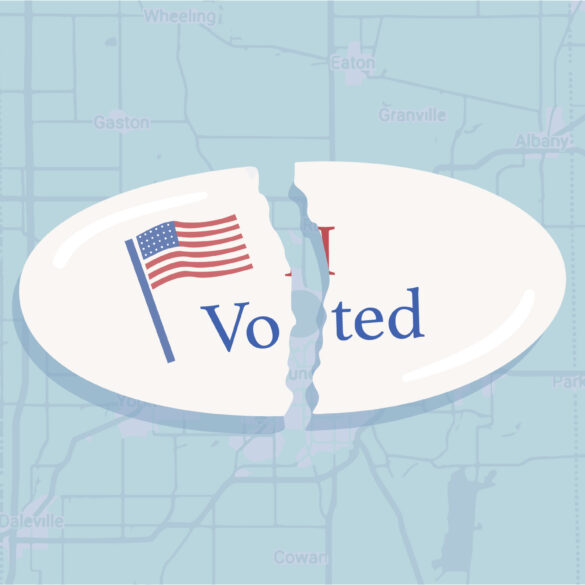In the most recent Delaware county primary, which took place May 7, 74,508 people were registered to vote.
Fewer than a quarter of those registered voters actually cast a vote.
This 18.3 percent voter turnout or percentage of eligible voters who vote in an election is not abnormal for Muncie and the surrounding Delaware County area. In the 2020 presidential election, Delaware County had a voter turnout of 58 percent meaning that just over half of registered voters cast their vote.
This percentage is tied for the lowest voter turnout rate out of all 92 counties in Indiana.
Indiana State Representative Sue Errington (D-District 34,) said this consistent downfall of voter turnout was due to a multitude of reasons, one of which is Indiana’s low civic engagement.
“The entire state is also low on voter registration,” Errington says. “… If you don’t get registered, then you’re not going to have voter turnout.”
Errington says she believes this upcoming presidential election will significantly affect young people, particularly college students. She claimed there’s “a lot at stake” for young individuals.
“I don’t think people realize how much local government affects their lives,” Errington says.
Former mayoral candidate and Development Director for Shafer Leadership Academy Jeff Robinson (D) agreed that educating Muncie residents and youth voters about the importance of local elections is crucial.
During his campaign, Jeff experienced the lack of voter turnout firsthand, losing the mayoral race by fewer than 500 votes.
“I knocked on about 17,000 doors in Muncie city limits. Most people don’t know what’s going on … people didn’t know what was happening on major projects in the city,” Jeff says. “I think apathy goes a long way, and I think that’s national. I don’t think that’s just a Muncie problem, but people are just sick of politics, and people are sick of voting and sick of elections.”
Jeff says a huge contributor to low voter turnout is the youth population and their thoughts and opinions.
According to the Kaiser Family Foundation (KFF), only 39 percent of Indiana’s registered voters aged 18 to 24 voted in the 2020 presidential election.
According to Ball State University Center for Economic and Civic Learning’s 2024 Voting Trends, there has been “a significant decline in student voting rates from 2018 to 2022, with an 11 percent drop overall.”
Jeff says this has to change. While he had ideas for on-campus voting polls and registration booths, he says people on the opposite side of the aisle blocked the initiatives.
Ensuring Ball State students can vote would benefit not only Muncie but students’ quality of life on and off campus as well, says Jeff.
“Ball State students could have a tremendous amount of power in this community if you know you don’t have to go back home to vote,” Jeff says. “You can register right here, and you can choose to vote right here … Ball State students can help with [voting to fix] the roads [and] sidewalks.”
Candidate for the Indiana House of Representatives District 34 Susan Dillon (R) says Ball State voters have been a focus for her party as well.
“I know that our county Republican Party is attempting to look into that and see what kind of support is needed in the Ball State area to help support specifically the Republican voters that are on campus,” she says.
Susan acknowledged while students can play a big role, another key part of increasing voter turnout is ensuring voters know their candidates.
“If a candidate has not earned my vote, and I don’t know who they are, what they stand for, what their plan is for the position that they’re going into, quite frankly, I don’t want to vote for them. I can appreciate people not wanting to show up and vote when they don’t even know who the candidates are,” she says.
Susan says enacting these suggested measures and encouraging voter education will not immediately fix low voter turnout but could begin to turn it around for the county and the state.
Errington agreed and believes the importance of educating voters on the significance of their vote, and on who their candidates are is key.
Jeff says that while all of these ideas can help, low voter turnout might be more difficult to permanently fix.
“I think those things would certainly help, but I mean, how do you fix apathy?
… You know, I had people say, ‘Oh, my vote doesn’t matter.’ Well, it does … it’s tough to fix that,” he says.
Eligible but unregistered Indiana voters can register either online, via mail, or in person.
Contact Maci Hoskins via email at maci.hoskins@bsu.edu or Trinity Rea via email at trinity.rea@bsu.edu.
Sources: Delaware County Election Day, Indiana Government, Kaiser Family Foundation, Ball State University Center for Economic and Civic Learning




